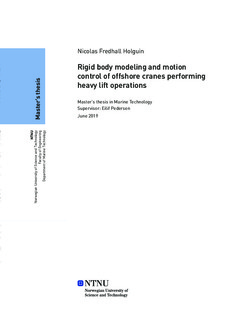| dc.contributor.advisor | Pedersen, Eilif | |
| dc.contributor.author | Holguin, Nicolas Fredhall | |
| dc.date.accessioned | 2019-10-17T14:06:52Z | |
| dc.date.available | 2019-10-17T14:06:52Z | |
| dc.date.issued | 2019 | |
| dc.identifier.uri | http://hdl.handle.net/11250/2622943 | |
| dc.description.abstract | Denne avhandlingen er en fortsettelse av arbeidet utført i Gyberg (2017) relatert til modellering av offshore-kraner, og har som formål å videreutvikle kransimuleringsmodellen. Derfor presenteres en omfattende beskrivelse av teorien som tilrettelegger for utvidelsen og utviklingen av simuleringsmodellen. Tilleggsfunksjonene inkluderer en forbedret lastmodell, et kranstyringssystem basert på invers dynamikk, et tuggervinsjsystem og en dynamisk modell av et koblet kran- og fartøyssystem.
Stivt legeme-antagelser og Lagrange-mekanikk legger grunnlaget for modelleringen av kranen, lastmodellen, og det flytende fartøyet, mens wiredynamikken er tilnærmet med serier av masse-fjær-demper-systemer. For å kontrollere bevegelsen til krantuppen er en invers dynamikkregulator designet for å kalkulere de nødvendige aktuatorkreftene. Tuggervinsjer med aktiv kraftkontroll er festet til lasten for å forhindre rykklaster og begrense pendelbevegelser. Koeffisientene som er relatert til de hydrodynamiske lastene er gitt av tilgjengelig data fra eksperimenter og approksimeringsmetoder. Alle modellene er utviklet med hensyn til implementering i et miljø tilpasset bond graph modellering.
Et case-studie ble utført for å validere det implementerte tuggervinsjsystemet og for å evaluere ytelsen til kontrollalgoritmen. Den implementerte wiredynamikken viser å samsvare med det velkjente simuleringsverktøyet SIMA. Dette framkommer gjennom en sammenligning av lastene som oppstår i tuggerwirene når de er utsatt for en sjøtilstand med Hs = 2.5m og Tp = 10s. Deretter brukes kraftkontrollere til å forhindre rykklaster, og de indikerer lovende resultater. Imidlertid er kontrollalgoritmen ikke gunstig med tanke på å begrense pendelbevegelsen til lasten. Derfor er mer sofistikerte kontrollere nødvendige for å både forhindre rykklaster og begrense pendelbevegelser. Legg merke til at grunnet forsinkelser både i utviklingen av simuleringsmodellen og på MCMR Laben, ble tuggervinsjsystemet ikke implementert på kranmodellen i laben.
Et annet case-studie ble gjennomført for å utvide simuleringsmodellen til å inkludere frihetsgradene som introduseres når kranen monteres på et flytende fartøy. Den dynamiske kran- og fartøysmodellen er utviklet med Lagrange-mekanikk og er tilpasset et bond graph miljø ved bruk av kvasikoordinater. Relevante hydrodynamiske laster som gjenopprettende krefter og momenter, tilleggsmasse, dempning og bølgeeksitasjonskrefter er inkludert i modellen. Kran- og fartøysoppførselen er sammenlignet med data fra en skipsmodell i SIMA. Med tanke på et sett av tilnærmede hydrodynamiske koeffisienter og skipsparametere, er resultatene relatert til modellresponsen ansett som tilfredsstillende. | |
| dc.description.abstract | This thesis is a continuation of the work carried out in Gyberg (2017) regarding the modeling of offshore cranes and seeks to further improve the crane simulation model that was developed. Hence, it presents a comprehensive description of the theory that facilitates the extension and development of the simulation model. The additional features include an improved payload model, an inverse dynamics control system, a tugger winch system, and an interconnected crane and vessel dynamics model.
Rigid body assumptions and Lagrangian mechanics lay the foundation for the modeling of the crane, the payload, and the floating vessel, while the wire dynamics are approximated by a series of mass-spring-damper systems. To control the motion of the crane tip, an inverse dynamics controller is designed to calculate the required actuator forces. Tugger winches with active tension control are attached to the payload to prevent snap loads and limit pendulum motion. The coefficients related to the hydrodynamic loads are obtained through available experimental data and methods of approximation. All the models are developed with respect to implementation in a bond graph environment.
A case study is carried out to validate the implemented tugger winch system and to evaluate the performance of the control algorithm. To begin with, the implemented wire dynamics are proven to behave similarly to the acknowledged simulation tool SIMA. It is proven through a comparison of the loads that are induced in two tugger wires during a sea state with Hs = 2.5m and Tp = 10s. Then, tension controllers are employed to prevent snap loads, and they show promising results. However, the control algorithm is suboptimal in regard to limiting the pendulum motion of the payload. Hence, more sophisticated controllers are required to both prevent snap loads and limit pendulum motions. Note that due to delays in the progress of the simulation model and in the MCMR Lab, the tugger winch system was not implemented on the model crane in the lab.
A second case study is performed to further extend the simulation model to include the degrees of freedom that are introduced when the crane is mounted onto a floating vessel. The dynamic model of the crane and vessel is developed with the framework of Lagrangian mechanics and is suited to a bond graph environment by applying quasi-coordinates. Relevant hydrodynamic loads such as restoring forces and torques, added mass, damping and wave excitation loads are included in the model. The crane and vessel behavior is compared with data from a ship model in SIMA. With the approximation of hydrodynamic coefficients and ship parameters in mind, the results regarding the model response are deemed satisfactory. | |
| dc.language | eng | |
| dc.publisher | NTNU | |
| dc.title | Rigid body modeling and motion control of offshore cranes performing heavy lift operations | |
| dc.type | Master thesis | |
